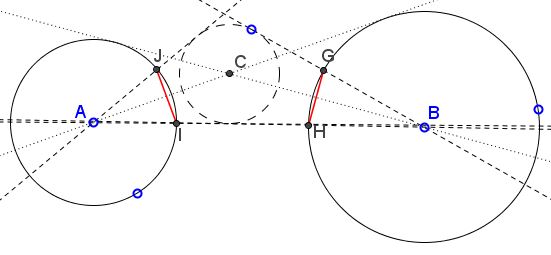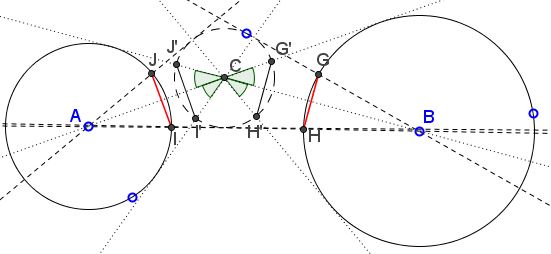Eyeballing a Ball
What is this about?
Problem
$(A)$ and $(B)$ are two non-intersecting circles. $C$ is one of the points of intersection of the tangents from $A$ to $(B)$ with those from $B$ to $(A).$ $(C)$ is a circle with center $C.$ The tangents form $A$ to $(C)$ intersect $(A)$ in $I$ and $J.$ The tangents form $B$ to $(C)$ intersect $(B)$ in $G$ and $H.$

Prove that $IJ=GH.$
Hint
Not for nothing the problem's caption reads "Eyeballing a ball." This is to remind of the Eyeball theorem.
Solution
$C$ lies at the intersection of tangents from $A$ to $(B)$ and from $B$ to $A.$ For the two lines therefore could be looked at as the tangents from $C$ to $(A)$ and $(B).$ Note that the vertical angles the two lines form are equal. Add the missing pair of the tangents from $C$ to $(A)$ and $(B).$

Denote the points of intersction of the tangents from $C$ $I',J',G',H',$ as in the above diagram. By the Eyeball theorem, $IJ=I'J'$ and $GH=G'H'.$ By the remark about the vertical angles, their doubles are also equal: $\angle I'CJ'=\angle G'CH',$ making the subtending chords equal: $I'J'=G'H'.$ This proves the statement.
Acknowledgment
The problem has been posted by Dao Thanh Oai at the CutTheKnotMath facebook page; the solution is by Emmanuel Antonio José García (Dominican Republic).
![]()
|Contact| |Front page| |Contents| |Geometry|
Copyright © 1996-2018 Alexander Bogomolny73573238
